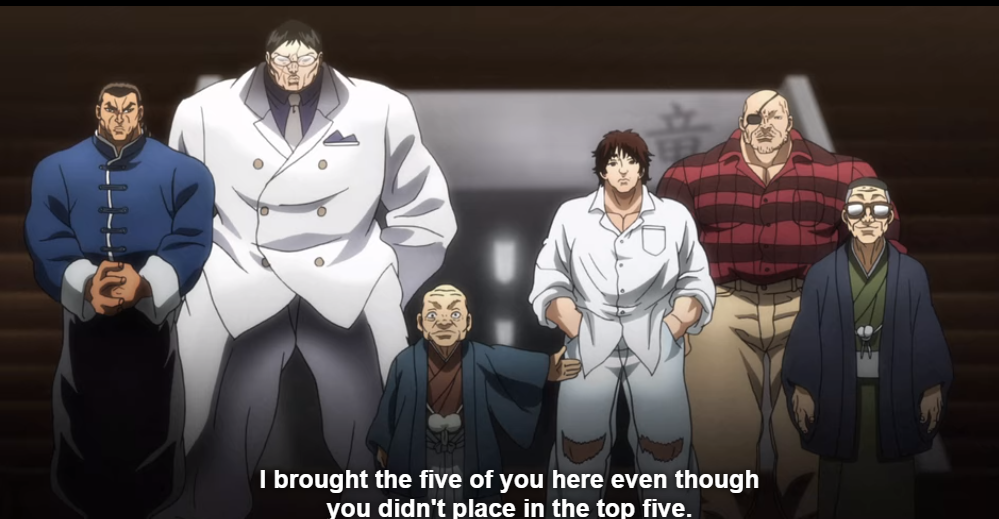Anime Review: Baki (2018)
Baki Hanma is not your average high school student. He may look normal if a teensy bulky and with a dull expression on his face with his school uniform on, but once he doffs his outer clothing, it’s clear that he’s possessed of superior musculature and covered in scars. For in reality, Baki is a “grappler”, a martial artist trained in the fighting arts since infancy. When not doing schoolwork, he participates in battles in the underground arena of Mitsunari Tokugawa in an effort to become stronger than his despised father Yujiro Hanma (and because he enjoys fighting.)

This Netflix anime series is based on New Grappler Baki, a manga sequel to Baki the Grappler, which started in 1991, and was previously animated. In that earlier series, Baki had become the champion of the Maximum martial arts tournament in the Korakuen Arena.
At the beginning of this series, five death row inmates from around the world simultaneously take it into their heads to escape from prison and head to Tokyo to “taste defeat.” Tokugawa gets wind of this and invites the dangerous killers to engage in a no holds barred battle with the top competitors of the Korakuen across an unsuspecting city. Predictably, this results in lots of bystanders getting injured or killed, multiple other martial artists getting drawn into the conflict, and massive amounts of mayhem.
In lighter moments, Baki finds that his superhuman prowess actually makes it harder to pass a physical fitness exam, and advances his relationship with his sweetheart Kozue.
Once the convicts are finally disposed of, Baki is invited to participate in a Chinese martial arts tournament that only happens once every hundred years, even though he’s still suffering the ill effects of previous battles. He’s joined here by Muhammed Alai, Jr. (Muhammed Ali, Jr. in the manga) who has perfected his father’s martial arts style. Young Alai wants to prove himself the best by beating Baki, and starts making moves on Kozue.
The outcome of that battle ends season three, except for a sequel hook episode. And that’s all that is on Netflix so far.
Good: lots of exciting martial arts action, which pretends that it’s plausible even though clearly being over the top. Baki’s a fairly likable main character who doesn’t use his superior muscles and fighting skills more than he has to, and has a good grasp on the idea of sexual consent.
I like the writer’s habit of inserting “Ripley’s Believe It or Not” type narrator asides to make it seem like the latest physical prowess bull the characters are pulling is just maybe possible, while not even bothering with real world plausibility for things that are not physical prowess. (Scotland has never used the electric chair for executions, even when it still had the death penalty.)
There are some very memorable characters, including Yujiro Hanma, aka “Oni/Ogre”, the World’s Strongest Creature. He’s the kind of ass who walks in on his son and the son’s girlfriend in bed and critiques the kids’ lovemaking technique.
Less good: The sheer worship of fighters and the warrior lifestyle by just about every male character and most of the female ones. This leads to way more carnage during the death row inmates arc than is necessary. Also, for the first half of that arc, despite the local martial artists knowing the invaders are multiple murderers with no compunction to fight fair, they keep being shocked when the inmates use underhanded or unconventional tactics.
Content notes: Lots of gory violence, frequently with mutilation. A fair amount of male and female nudity, and an extended onscreen sex scene (no genitals.) A certain amount of racism/ethnic prejudice by villains. Kaoru Hanayama, a Yakuza, has a sexist moment but learns better.
Kozue is kidnapped and stripped to her underwear at one point, and Alai pursues her romantically although she is clearly not interested and would rather just be friends, but no one in this part of the storyline even suggests rape, let alone attempts it. (That is not true of the earlier parts of the series.)
Recommended for fighting series fans who enjoy gory violence and not too strict adherence to realism.

